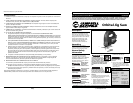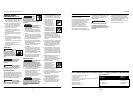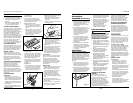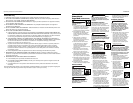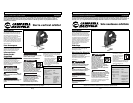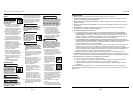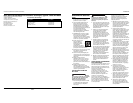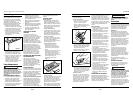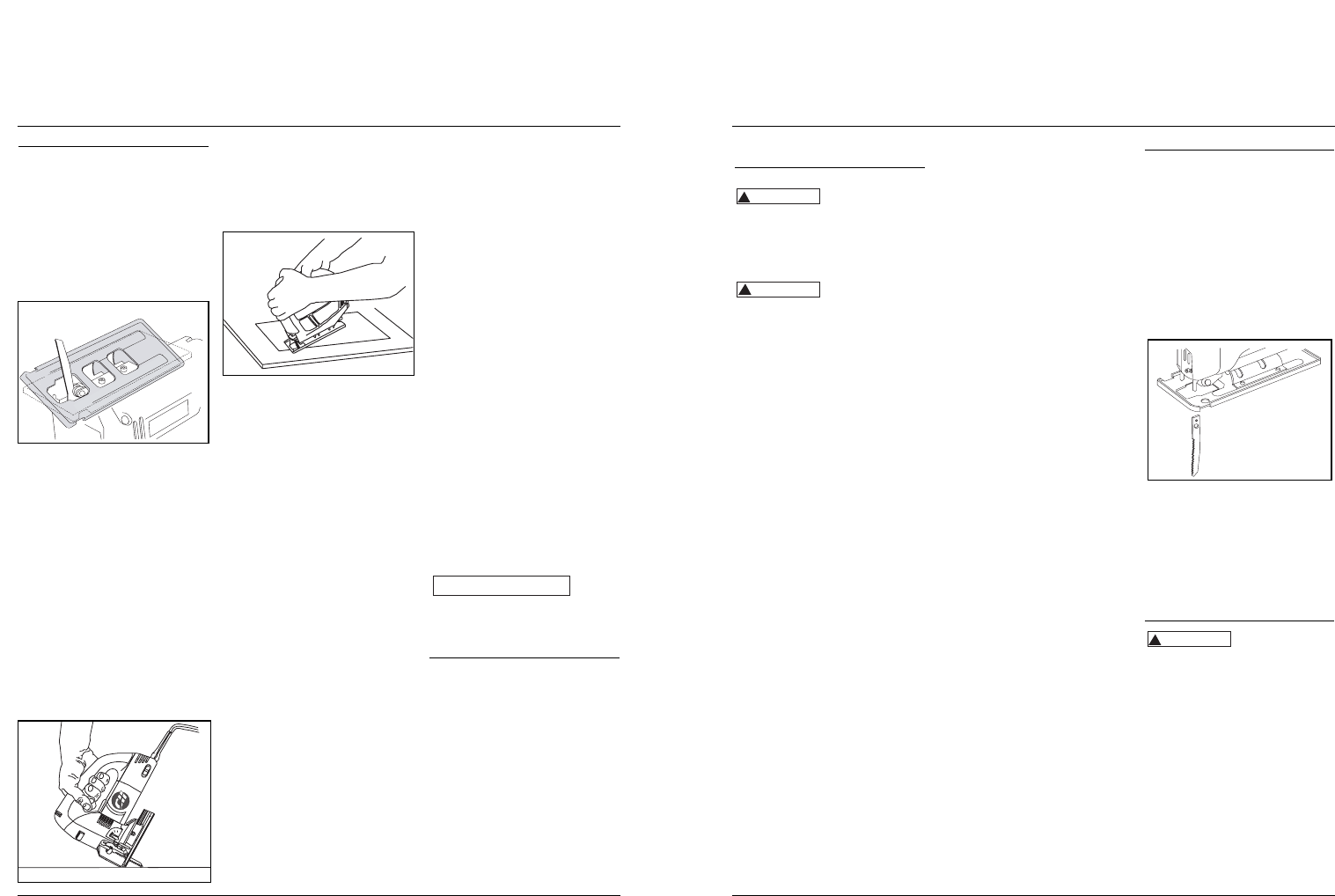
CORTES DIAGONALES/EN ÁNGULO
• Asegúrese de que la sierra esté
desenchufada de la fuente de
corriente antes de hacer ajustes
a los ángulos de corte.
• La placa base se puede inclinar 45°
en ambas direcciones para realizar
cortes en ángulo. Estos son valores
para 45° y para 90° contra la pieza
de trabajo. Para otros ángulos use
un graduador para medir
(Figura 2).
Hole Cutting
CORTES DE BOLSILLO
Los cortes de bolsillo se hacen en el
medio de la pieza de trabajo cuando
no pueden cortarse desde un borde.
Se pueden comenzar con un orificio
pretaladrado o la sierra vertical puede
crear un punto de inicio (corte por
penetración).
Los cortes por penetración no se
recomiendan para materiales más
duros como el acero y no se deben
usar las hojas de calar para cortes
por penetración.
CORTES POR PENETRACIÓN
1.Si el corte en bolsillo es de líneas
rectas, no se necesita un orificio
pretaladrado.
2.Toque el pie de la sierra sobre la
pieza de trabajo dejando la hoja
bien por encima del material
(Figura 3).
3.Asegúrese de que el valor orbital
esté en 0 y encienda la sierra.
4.Una vez que la sierra alcanza la
velocidad máxima, bájela
lentamente en la pieza de trabajo.
5.Mantenga ambas manos sobre la
sierra mientras esté cortando
(Figura 4).
6.Para 90° u otras esquinas en
ángulo, corte hasta la esquina
luego retroceda antes de
redondear la esquina. Una vez que
haya cortado el bolsillo, acérquese
a la esquina desde la dirección
contraria y corte el ángulo.
CORTES EN CÍRCULO
Una guía de corte en círculo puede
ayudarlo para cortar círculos. El
corte se debe preparar con un
orificio pretaladrado o un leve corte
por penetración próximo a la línea
de corte. Si usa una guía, asegúrese
de que cumpla con las instrucciones
de la sierra vertical y del fabricante.
Calados
Se pueden realizar trabajos
complicados con una sierra vertical
usando una hoja de calado. Asegúrese
de que la hoja se utilice de acuerdo a
las instrucciones del fabricante. Para
un mejor control, use la sierra en el
valor I con la hoja de calado. Esto
ofrece un corte y un manejo más
sencillo.
Corte de metales
• Antes de comenzar un corte de
metal, coloque el valor orbital
correspondiente 0 ó 1.
• Cuando corte piezas de trabajo de
metal, sujete el material con
abrazaderas y corte cerca del punto
de sujeción para reducir la
posibilidad de que se tuerza y la
vibración.
• Si la hoja comienza a vibrar o a
hacer un ruido excesivo, reemplace
la hoja con una hoja para cortes en
metal que tenga dientes más finos.
• Para metales blandos, la hoja se
puede obstruir por lo tanto use una
hoja con dientes más gruesos.
• Los conductos, hierro en ángulo
o tuberías se deben sujetar en una
prensa de tornillo y cortar lo más
cerca posible de la prensa.
• Los metales de hoja delgada deben
colocarse entre dos tablas de madera
o se deben colocar sobre tablones de
madera más gruesos, como madera
terciada y el diseño o diagramado se
debe poner encima. Esto permite
cortar el metal sin problemas y evita
el desgarro del material de metal.
• La hoja se puede lubricar para
facilitar el corte. Use una barra
de cera para corte, si hubiese
disponible, y use aceite para corte
cuando corte acero.
• La porción expuesta de la barra de
la sierra se debe mantener limpia.
Elimine frecuentemente los restos
de metal usando un paño con aceite.
Después de usar, deseche
adecuadamente el paño con aceite
para evitar riesgos de incendio.
EXTRACCIÓN DEL POLVO
Se pueden realizar operaciones de corte
limpias conectando esta herramienta a
una aspiradora. Introduzca la
manguera de la aspiradora en el
orificio de la parte trasera de la
herramienta. Baje la tapa para polvo
antes de poner la herramienta en
funcionamiento.
La extracción del polvo no se puede
realizar cuando se hacen cortes en
diagonal.
Mantenimiento
El servicio de la herramienta debe ser
realizado sólo por personal de
reparaciones calificado. El servicio
o mantenimiento realizado por
personas no calificadas puede provocar
riesgo de lesiones.
Limpieza
Limpie el polvo y los desechos de
los orificios y contactos eléctricos,
soplando con aire comprimido.
Los orificios de ventilación del motor
y los interruptores deben mantenerse
limpios y libres de materiales extraños.
No intente limpiarla introduciendo
objetos con punta a través de las
aberturas. Mantenga los mangos de
las herramientas limpios, secos y libres
de aceite o grasa. Use únicamente un
jabón suave y un paño húmedo para
AVISO
18 Sp
Manual de Instrucciones y Lista de Piezas
0
I
II
I
I
I
Figura 4
Figura 3
Funcionamiento (Cont.)
TOOL USE AND CARE
Do not use tool if
switch does not turn it ON or OFF. Any
tool that cannot be controlled with the
switch is dangerous and must be repaired.
1. This tool must NOT be modified or
used for any application other than
that for which it was designed.
Do not force the
tool. Use the correct
tool for your application. The correct tool
will do the job better and safer at the
rate for which it is designed.
2. Maintain tools with care. Keep
cutting tools sharp and clean.
Properly maintained tools with
sharp cutting edges are less likely
to bind and are easier to control.
3. Check for misalignment or binding
of moving parts, breakage of parts,
and any other condition that may
affect the tool’s operation. If
damaged, have the tool serviced
before using. Many accidents are
caused by poorly maintained tools.
4. Use only accessories that are
recommended by the manufacturer
for your model. Accessories suitable
for one tool may create a risk of
injury when used on another tool.
5. Some woods contain preservatives
which can be toxic. Take extra care
to prevent inhalation and skin
contact when working with these
materials. Request and follow all
safety information available from
your material supplier.
6. Store tools out of reach of children
and other untrained persons. Tools
are dangerous in the hands of
untrained users.
CAUSES AND USER PREVENTION
OF KICKBACK:
Kickback is a sudden reaction to a
pinched, bound or misaligned saw
blade, causing an uncontrolled saw to
lift up and out of the workpiece
toward the operator.
When the blade is pinched or bound
tightly by the kerf, or cutting slot,
closing down, the blade stalls and the
motor reaction drives the unit rapidly
back toward the operator.
If the blade becomes twisted or
misaligned in the cut, the teeth at the
back edge of the blade can dig into
the top surface of the wood causing
the blade to climb out of the kerf and
jump back toward operator.
!
CAUTION
!
WARNING
Kickback is the result of tool misuse
and/ or incorrect operating procedures
or conditions and can be avoided by
taking proper precautions as given
below:
1. Maintain a firm grip with both
hands on the saw and position your
body and arm to allow you to resist
kickback forces. Kickback forces can
be controlled by the operator, if
proper precautions are taken.
2. When blade is binding, or when
interrupting a cut for any reason,
release the trigger and hold the saw
motionless in the material until the
blade comes to a complete stop.
Never attempt to remove the saw
from the work or pull the saw
backward while the blade is in
motion or kickback may occur.
Investigate and take corrective
actions to eliminate the cause of
blade binding.
3. When restarting a saw in the
workpiece, center the saw blade in
the kerf, or cut, and check that saw
teeth are not engaged into the
material. If saw blade is binding, it
may walk up or kickback from the
workpiece as the saw is restarted.
4. Support large panels to minimize
the risk of blade pinching and
kickback. Large panels tend to sag
under their own weight. Supports
must be placed under the panel on
both sides, near the line of cut and
near the edge of the panel.
5. Do not use dull or damaged blades.
Unsharpened or improperly set
blades produce narrow kerf causing
excessive friction, blade binding and
kickback.
6. Blade depth and bevel adjusting
locking levers must be tight and
secure before making cut. If blade
adjustment shifts while cutting, it
may cause binding and kickback.
7. Use extra caution when making a
“Pocket Cut” into existing walls or
other blind areas. The protruding
blade may cut objects that can
cause kickback.
8. Be cautious of pitchy, knotty, wet or
warped stock. These are most likely
to create pinching conditions and
possible kickback.
Assembly
ATTACHING THE BLADE
Always unplug tool and place the
switch in the locked or OFF position
before making any assembly,
adjustments or changing accessories.
Such preventive safety measures
reduce the risk of starting the tool
accidentally.
1. Using the hex key provided, loosen
the two blade lock bolts enough for
a blade to be removed or inserted.
2. Insert blade in slot with teeth facing
forward (Figure 1). The blade’s top
should be inserted far enough to
touch blade clip.
3. While blade is in fitted slot and
touching blade clip top, tighten the
blade lock bolts securely.
4. Test saw in a safe direction, away
from others, before beginning use
with new blade. A poorly secured
blade risks the possibility of it
coming unattached during operation
that could result in serious injury.
Operation
Use safety
equipment. Always wear eye
protection. Dust mask, non-skid safety
shoes, hard-hat, or hearing protection
must be used for appropriate condition.
GENERAL OPERATION
• Always clamp the work piece securely
on a saw horse or bench.
• Before cutting, make sure the space
below the material to be cut is
deeper than the saw blade.
• If using a fence or guide, make sure it
is securely fastened and complies with
manufacturer’s instructions.
• Certain blades are useful for different
types of cuts and materials. Make
sure the blade in use is approved by
the manufacturer for the operation
being performed.
!
WARNING
3
www.chpower.com
DG460500CK
General Safety
Information (Cont’d.)
Figure 1
Figura 2



